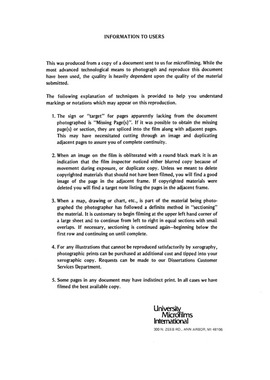| dc.contributor.author | Elshabani, Abdelgader, | en_US |
| dc.date.accessioned | 2013-08-16T12:28:23Z | |
| dc.date.available | 2013-08-16T12:28:23Z | |
| dc.date.issued | 1981 | en_US |
| dc.identifier.uri | https://hdl.handle.net/11244/4882 | |
| dc.description.abstract | Cities in the developing countries have increasing numbers of people living below the poverty line, and who have real "transportation needs" that cannot be analyzed adequately by the existing "demand models" which are inflexible in terms of the changing objectives of development, urbanization, mobility, employment, and levels of expenditures on travel in developing countries. | en_US |
| dc.description.abstract | The main objective of this study is to prepare a framework for analysis that addresses the transportation needs of the poor in developing countries and provides travel estimation procedures for quick response to policy questions in the context of the dynamic urban changes and data inadequacies in the cities of the developing countries. | en_US |
| dc.description.abstract | It is to be noted that the proposed analysis framework will be useful only to those developing countries that have a relatively large number of people who are considered to be poor and those countries have to be politically committed to providing the "basic needs" for their poor segment of the population. | en_US |
| dc.description.abstract | In this study a framework for transportation needs analysis is proposed where the key goal is to provide a desirable level of access to employment, health, education and other opportunities that would satisfy the transportation needs of the urban population. The proposed analysis framework is both nonspatial and spatial. The main objective of nonspatial analysis is to make use of data obtained from household interviews for policy analysis, such as: the effect of road pricing policies on the mobility of different income groups, and the budget needed to meet the poor's standards of accessibility and expenditures on travel. The main objectives of spatial analysis are to identify the zones in an urban area with deficiencies in transportation supply and to estimate the trips needed by purpose at the zonal level. Three examples are provided of the proposed analysis framework. In the example of Amman, Jordan, the proposed approach was tested against the conventional demand approach which was used in a recent (February 1981) transportation study of Amman, Jordan. | en_US |
| dc.format.extent | xi, 273 leaves : | en_US |
| dc.subject | Transportation. | en_US |
| dc.title | Short range, quick response transportation planning to meet the needs of the poor in developing countries. | en_US |
| dc.type | Thesis | en_US |
| dc.thesis.degree | Ph.D. | en_US |
| dc.thesis.degreeDiscipline | Department of Philosophy | en_US |
| dc.note | Source: Dissertation Abstracts International, Volume: 42-07, Section: A, page: 3325. | en_US |
| ou.identifier | (UMI)AAI8129398 | en_US |
| ou.group | College of Arts and Sciences::Department of Philosophy | |
